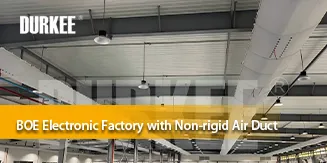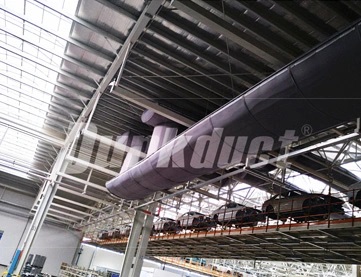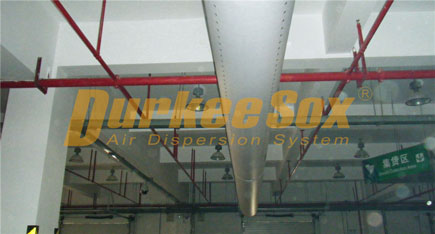 BOE Vietnam Factory: Non-rigid Air Duct Solutions for Electronic Industry
BOE Vietnam Factory: Non-rigid Air Duct Solutions for Electronic Industry
 Why Fabric Air Ducts Are the Preferred Choice for Ventilation in Large Spaces
Why Fabric Air Ducts Are the Preferred Choice for Ventilation in Large Spaces
 The Difference Between Non-Rigid Air Ducts and Rigid Ductwork
The Difference Between Non-Rigid Air Ducts and Rigid Ductwork
In industrial plants, stadiums, exhibition centers, and large-scale warehouses, the design and choice of ventilation systems directly influence indoor air quality, environmental comfort, and operational efficiency. Among the growing solutions, the Fabric Air Duct stands out as a highly effective and adaptable option tailored to the unique requirements of expansive high-ceiling spaces. Compared with traditional systems, fabric duct solutions are not only efficient but also cost-effective, making them increasingly favored by project designers and contractors worldwide.
One of the most significant challenges in large spaces is the complexity of the building structure. Traditional metal ducts are heavy, requiring extensive support structures, sophisticated lifting equipment, and longer installation times. This increases both labor intensity and structural burden on the building. A Fabric Air Duct, however, is inherently lightweight, often weighing only a fraction of conventional rigid systems. This means fewer suspension points, reduced dependency on heavy-duty supports, and a more streamlined installation process. Companies such as Durkee®, with its renowned Durkduct® brand, have developed modular designs that allow fabric ducts to be installed quickly and efficiently, making them particularly suitable for projects with tight deadlines and large surface areas.

Large, open spaces often struggle with uneven airflow distribution. This can result in uncomfortable hot and cold spots, as well as poor indoor air quality. Fabric ducts are designed to solve these challenges by utilizing permeable surfaces, micro-perforations, or targeted jet nozzles to disperse air evenly across the entire area. Unlike metal ducts, which may concentrate airflow in specific zones, fabric ducts create a balanced environment, ensuring that every corner of a facility benefits from optimal air circulation. As a global leader among fabric duct manufacturers, Durkee has advanced the technology of air dispersion systems, providing clients in more than 36 countries with innovative solutions that enhance occupant comfort in high-ceiling environments.

To better understand why fabric ducts are gaining popularity, it is essential to compare them directly with rigid metal ductwork.
Feature | Fabric Air Duct | Rigid Ductwork (Metal) |
Weight | Extremely lightweight, reduces structural load | Heavy, requires strong supports and lifting |
Installation | Fast, modular, less labor-intensive | Complex, time-consuming, more costly labor |
Airflow Distribution | Even, customizable through surface and perforations | Uneven, often concentrated in limited zones |
Maintenance | Easy to remove, wash, or replace | Difficult, time-consuming, can disrupt usage |
Flexibility in Design | Adaptable to layout changes, flexible material | Rigid and fixed, difficult to modify |
This direct comparison highlights how the flexibility and practicality of fabric ducts address the unique ventilation challenges of large-scale facilities, offering distinct advantages over conventional alternatives.

Another reason why fabric ducts are the preferred solution is their straightforward maintenance. Metal ducts tend to accumulate dust and bacteria over time, which can be costly and disruptive to clean. On the other hand, fabric ducts can be easily removed, washed, and reinstalled without major interruptions to daily operations. This not only ensures healthier indoor air but also reduces the total maintenance burden over the system’s lifecycle. For industries where hygiene is critical, such as logistics centers handling sensitive goods, this ease of maintenance offers a significant advantage.

High-ceiling spaces often undergo layout changes or functional upgrades over time. Traditional rigid systems are difficult and expensive to modify, but fabric ducts offer superior adaptability. Their flexibility allows them to be adjusted or relocated based on new space configurations, ensuring long-term usability without the need for complete replacement. Durkee’s commitment to innovation ensures that its fabric ducts are not only efficient but also versatile, meeting the evolving demands of modern architecture and engineering.

The growing preference for Fabric Air Duct systems in large-scale facilities stems from their lightweight design, installation efficiency, superior airflow distribution, and long-term cost-effectiveness. Compared with rigid systems, fabric ducts present a smarter and more adaptable choice for modern ventilation needs. Global leaders like Durkee®, through its Durkduct® brand, continue to pioneer advanced solutions that deliver both performance and sustainability. In high-ceiling environments where efficiency, comfort, and adaptability are crucial, fabric ducts have proven to be the future-oriented answer, securing their place as the preferred option among fabric duct manufacturers worldwide.